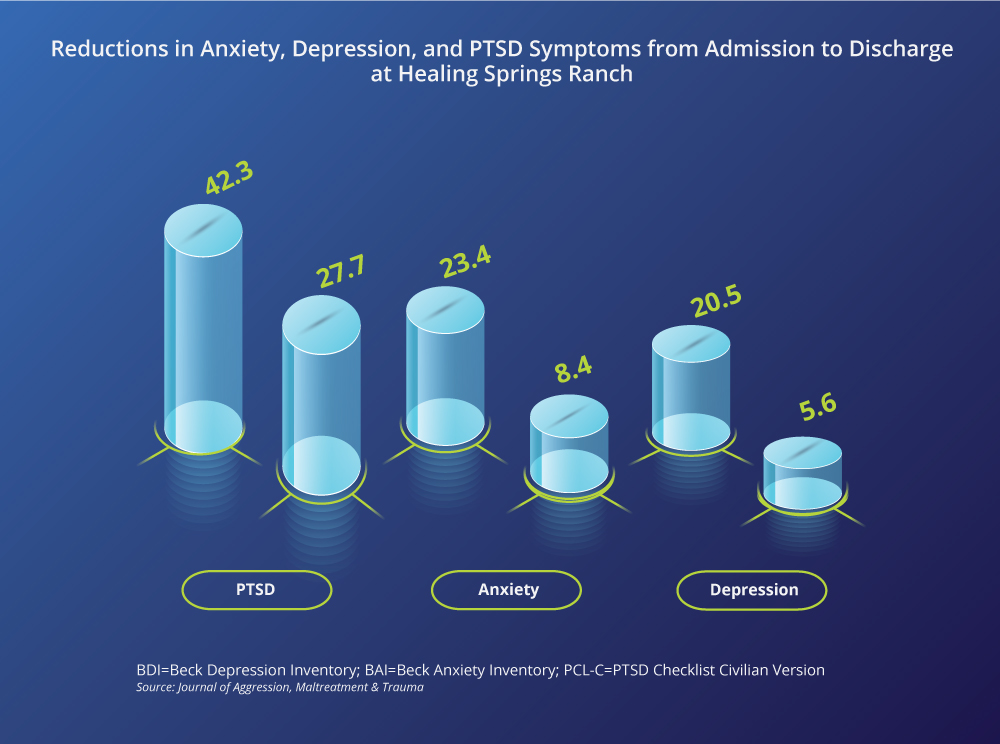Reductions in Symptomatology at a Residential Treatment Center for Substance Use Disorders
Latest Research Results - November 2018
"Reductions in Symptomatology at a Residential Treatment Center for Substance Use Disorders” article by Colin A. Rossa, Melissa Caldwell Engle, and Billie Baker in the “Journal of Aggression, Maltreatment & Trauma” The Colin A. Ross Institute for Psychological Trauma and Healing Springs Ranch. Download Results.

Preliminary Research Results
In an effort to validate the efficacy of our “Integrated Addiction Model™”, Healing Springs Ranch is committed to research on its treatment program and the responses of residents to treatment, both during their stays at Healing Springs Ranch and after discharge. We have just completed gathering and analyzing our preliminary data. The group average age was 42.9 years. Their average length of stay at Healing Springs Ranch was 46.5 days.
Average scores on measures completed only on admission were: Drug Abuse Screening Test (DAST), 9.2. What do these numbers mean? On the DAST, a cutoff score of 6 is often used to screen for substance abuse, so an average score of 9.2 confirms that our residents have serious addiction problems.
The Adverse Childhood Experiences Questionnaire (ACE), 3.3. Scores on the ACE range from 0-10; an average score of 3.3 indicates significant childhood trauma.
Questionnaires Completed on Both Admission and Discharge were:
PTSD Checklist-Civilian Version (PCL-C), the DES (Dissociative Experiences Scale), The Beck Depression Inventory (BDI), and The Beck Anxiety Inventory (BAI).
On the PCL-C, the average score upon admission was 42.7 and at discharge 30.3. These scores indicate that a person has experienced a lot of trauma, and the drop in a score of 10 or more is considered to be evidence of a good response to treatment.
The average DES scores in our sample of residents were in the normal range on admission, but a few had very elevated scores. We will gather more data to see if high-scorers on the DES experience significant score reductions while at HSR. We are also in the process of creating a new scale that measures compartmentalization, a more subtle form of dissociation, often seen in the addictive client.
However, the most exciting pre and post data collection came from a comparison between the pretreatment and post-treatment scores on the BAI and BDI. These questionnaires are two widely used standardized tests. The BAI initial mean score was 23.1 (S.D. = 13.0) and the discharge mean score was 8.7 (S.D. = 8.6), t = 5.6195, p<.00001. These results mean that our results were highly significant.
In understanding the BDI, it is a commonly used test in the pharmaceutical industry. This questionnaire is given to subjects before and after a trial drug has been given for a period of 6 weeks. This is one of the methods used to verify the efficacy of how each drug affects the specific symptoms of depression. To qualify as a candidate for a trial drug study, subjects must score at least a 20 on the BDI which is considered evidence of a major depressive episode.
The pharmaceutical companies were elated to announce that the use of their trial antidepressant, over a period of 6 weeks, dropped the initial score of 25.5 on the pre-test to a 15 on the post-test. A decrease of 10.5. Healing Springs Ranch clients, in comparison, scored a mean initial score of 22.1 (S.D. = 10.8) meaning they were depressed enough at admission to qualify for a drug study trial. The mean discharge score was 6.6 (S.D. =5.9), t = 7.6612, p < .00001. This is a decrease of 15.5. A greater reduction in depression than is typically seen in an antidepressant trial over the same time period.
Initial Research Results
Our initial research shows that the treatment at Healing Springs Ranch is a system that leads to results. We also plan to present our treatment results at conferences and publish them in professional journals.
